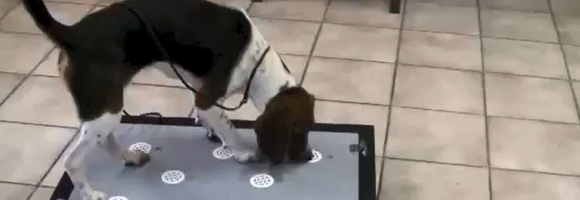Can a Canine Detect Polar Bear Pregnancy?
 CINCINNATI – (November 4, 2013) What do a two-year-old Beagle, named “Elvis,” and scientists at the Cincinnati Zoo’s Center for Conservation & Research of Endangered Wildlife (CREW) have in common? Well, the two are working together to determine pregnancy in polar bears found in zoos throughout North America.
CINCINNATI – (November 4, 2013) What do a two-year-old Beagle, named “Elvis,” and scientists at the Cincinnati Zoo’s Center for Conservation & Research of Endangered Wildlife (CREW) have in common? Well, the two are working together to determine pregnancy in polar bears found in zoos throughout North America.
Worldwide, traditional methods of pregnancy detection, such as progesterone monitoring and ultrasound examination, are not effective at diagnosing pregnancy in polar bears, so scientists at CREW have gotten creative. In collaboration with professional dog trainer, Matt Skogen, owner of Iron Heart High Performance Working Dogs, and a beagle named Elvis, CREW is trying to determine if the sensitive noses of canines can distinguish a pregnant polar bear from a non-pregnant bear simply by smelling fecal samples.
“This is the first time sniffer dogs have been used in biomedical research as it relates to any wildlife species, making this project truly one-of-a-kind,” said Dr. Erin Curry, a Post-Doctoral Fellow studying polar bear reproduction at CREW. Currently, Elvis is demonstrating approximately 97% accuracy in positive identification of samples from pregnant females – which is not only incredible but nearly as accurate as human pregnancy tests that are available over-the-counter.
 “Collaboration is crucial in all conservation efforts, but especially when it comes to such ‘out of the box’ ventures as this,” said Dr. Curry. “Matt and his team at IronHeart have embraced this project completely, spending countless hours training Elvis for this exceptionally unique purpose, and their contribution to CREW’s research has been invaluable.” For CREW’s study, over 200 training samples from polar bears of known pregnancy status were chosen retrospectively and sent to Iron Heart, where Elvis is learning to identify the samples that came from pregnant females.
“Collaboration is crucial in all conservation efforts, but especially when it comes to such ‘out of the box’ ventures as this,” said Dr. Curry. “Matt and his team at IronHeart have embraced this project completely, spending countless hours training Elvis for this exceptionally unique purpose, and their contribution to CREW’s research has been invaluable.” For CREW’s study, over 200 training samples from polar bears of known pregnancy status were chosen retrospectively and sent to Iron Heart, where Elvis is learning to identify the samples that came from pregnant females.
Beginning in January 2013, Matt began training Elvis for approximately one hour a day. During that initial training and testing period, Elvis was already working at a high accuracy level, but his real exam is occurring right now.
“When I was contacted by Dr. Curry at the Cincinnati Zoo I was honored to have the opportunity to work on such a unique project,” said Matt Skogen, Professional Working Dog Trainer, at IronHeart High Performance Working Dogs. “I felt the project was a noble cause and jumped at the opportunity to provide the research and work toward a positive conclusion.”
On October 28, Elvis was presented with 34 samples, two samples from each of the 17 polar bears that mated this past spring. The 17 female polar bears, including the Cincinnati Zoo’s “Berit,” living in 14 zoos throughout the U.S. and Canada are potentially pregnant. Over the next two weeks, Elvis will be testing and double-testing samples to come up with predictions for this cubbing season. Once Elvis’ work is complete, his results will be shared with Dr. Curry and she will begin the process of reaching out to institutions, informing them on whether or not Elvis indicated that their polar bear(s) is pregnant. Those institutions should have a few weeks to further prepare for impending births since the majority of births occur from Nov. 13 to Dec. 15.
Pregnant bears that enter dens in the wild are generally undisturbed and do not eat, drink, or defecate for months. In contrast, non-pregnant bears do not spend the winter in dens. Zoos do their best to mimic wild conditions most appropriate for their bears so an accurate pregnancy test would be very helpful in guiding the management strategy throughout the winter season. Pregnant bears could be properly isolated with minimal disruption while being closely monitored by camera 24/7 in anticipation of a birth, whereas non-pregnant females would be allowed to enjoy the cool winter season swimming and socializing out on exhibit with male and/or female counterparts.
“Figuring out which component of the samples Elvis recognizes in the pregnant bears may allow us to work backwards and finally identify the polar bear pregnancy factor, once and for all,” said Dr. Curry. “In addition, we are considering how sniffer dogs can continue to be trained and work in both the wild and zoos to help save some of the world’s most endangered animals.”
There is growing interest in the utilization of dogs for medical purposes. Trained sniffer dogs are employed in a variety of roles, including the detection of food allergens, the onset of seizures in epileptics, and alterations in blood sugar in diabetics. Some groups have even trained dogs to distinguish breath, blood, and fecal samples originating from human patients with lung, ovarian, and colon cancers from those of healthy individuals.
Polar bears depend on sea ice for everything (hunting, denning, finding mates). Global warming is causing a decrease in the amount of sea ice, which in turn has shortened the hunting season, so polar bears have less time to hunt and put on enough fat to survive the summer months. Polar bears have been listed as a Threatened Species under the Endangered Species Act. The number of polar bears in the wild is expected to decline primarily due to starvation and decreased reproduction. At the 2009 meeting of the IUCN Polar Bear Specialist Group, scientists reported that of the 19 subpopulations of polar bears: 8 are declining, 3 are stable, and only 1 is increasing (data not available for the other 7).
Unless we take action to reduce the greenhouse gas emissions responsible for global warming, we could lose 2/3 of the world’s polar bears by mid-century and all of them by the end of the century. “Polar bears are a high profile, flagship species for conservation. Scientists are diligently trying to learn all we can about them, in both the wild and zoos, as we develop action plans for their survival,” said Dr. Curry. “It is not unlikely that working with Elvis will be a critical factor in unlocking the mysteries of polar bear reproduction, contributing towards saving one of the world’s most beloved animals.”


